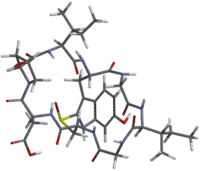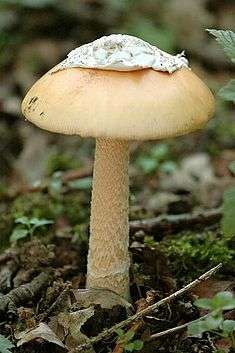Amanullinic acid
Amanullinic acid is a cyclic nonribosomal peptide. It is an amatoxin, all of which are found in several members of the mushroom genus Amanita. Amanullinic acid is relatively non-toxic( oral LD50 >20 mg/kg in mice).[1]
 | |
 | |
| Names | |
|---|---|
| Other names
1-L-Aspartic acid-3-isoleucine-alpha-amanitin | |
| Identifiers | |
3D model (JSmol) |
|
| ChemSpider | |
PubChem CID |
|
| |
| |
| Properties | |
| C39H53N9O13S | |
| Molar mass | 887.96 g/mol |
Except where otherwise noted, data are given for materials in their standard state (at 25 °C [77 °F], 100 kPa). | |
| Infobox references | |
Toxicology
Like other amatoxins, amanullinic acid is an inhibitor of RNA polymerase II.
gollark: It is important for hygiene purposes or something.
gollark: The glass you transfer milk to is NOT superfluous.
gollark: Yes, that's right, good inference.
gollark: Oh, <@734160436194181170>?
gollark: Rounded to the nearest 2021, it is 2080.
See also
References
- T. Wieland; Faulstich H. (1978). "Amatoxins, Phallotoxins, Phallolysin, and Antamanide: the Biologically Active Components of Poisonous Amanita Mushrooms". CRC Critical Reviews in Biochemistry. 5 (3): 185–260. doi:10.3109/10409237809149870. PMID 363352.
External links
This article is issued from Wikipedia. The text is licensed under Creative Commons - Attribution - Sharealike. Additional terms may apply for the media files.
